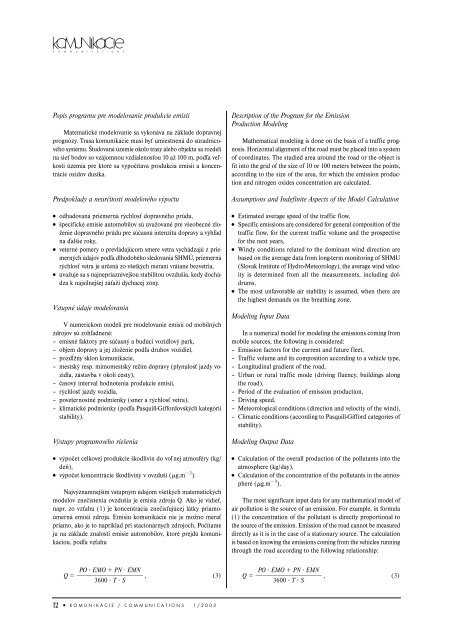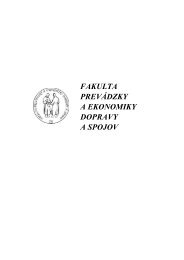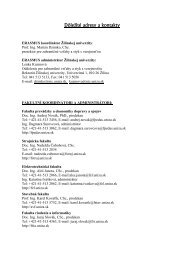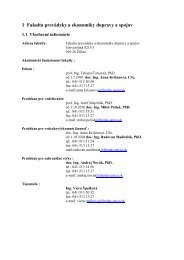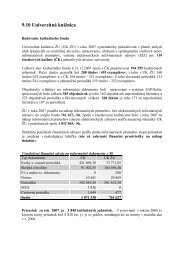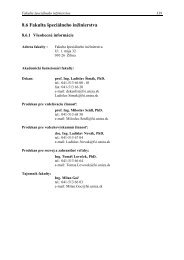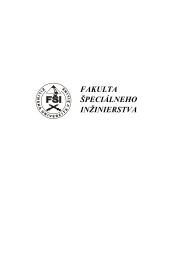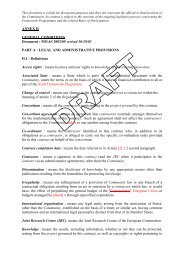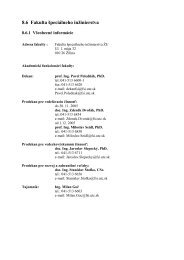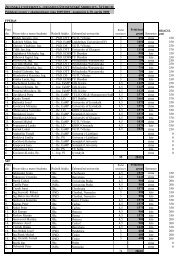posudzovanie vplyvu automobilovej dopravy na - Žilinská univerzita
posudzovanie vplyvu automobilovej dopravy na - Žilinská univerzita
posudzovanie vplyvu automobilovej dopravy na - Žilinská univerzita
Create successful ePaper yourself
Turn your PDF publications into a flip-book with our unique Google optimized e-Paper software.
C O M M U N I C A T I O N S<br />
I S<br />
Popis programu pre modelovanie produkcie emisií<br />
Matematické modelovanie sa vykonáva <strong>na</strong> základe dopravnej<br />
prognózy. Trasa komunikácie musí byť umiestnená do súradnicového<br />
systému. Študované územie okolo trasy alebo objektu sa rozdelí<br />
<strong>na</strong> sieť bodov so vzájomnou vzdialenosťou 10 až 100 m, podľa veľkosti<br />
územia pre ktoré sa vypočítava produkcia emisií a koncentrácie<br />
oxidov dusíka.<br />
Predpoklady a neurčitosti modelového výpočtu<br />
●<br />
●<br />
●<br />
●<br />
odhadovaná priemerná rýchlosť dopravného prúdu,<br />
špecifické emisie automobilov sú uvažované pre všeobecné zloženie<br />
dopravného prúdu pre súčasnú intenzitu <strong>dopravy</strong> a výhľad<br />
<strong>na</strong> ďalšie roky,<br />
veterné pomery o prevládajúcom smere vetra vychádzajú z priemerných<br />
údajov podľa dlhodobého sledovania SHMÚ, priemerná<br />
rýchlosť vetra je určená zo všetkých meraní vrátane bezvetria,<br />
uvažuje sa s <strong>na</strong>jnepriaznivejšou stabilitou ovzdušia, kedy dochádza<br />
k <strong>na</strong>jsilnejšej záťaži dýchacej zóny.<br />
Vstupné údaje modelovania<br />
V numerickom modeli pre modelovanie emisií od mobilných<br />
zdrojov sú zohľadnené:<br />
– emisné faktory pre súčasný a budúci vozidlový park,<br />
– objem <strong>dopravy</strong> a jej zloženie podľa druhov vozidiel,<br />
– pozdĺžny sklon komunikácie,<br />
– mestský resp. mimomestský režim <strong>dopravy</strong> (plynulosť jazdy vozidla,<br />
zástavba v okolí cesty),<br />
– časový interval hodnotenia produkcie emisií,<br />
– rýchlosť jazdy vozidla,<br />
– poveternostné podmienky (smer a rýchlosť vetra),<br />
– klimatické podmienky (podľa Pasquill-Giffordovských kategórií<br />
stability).<br />
Výstupy programového riešenia<br />
● výpočet celkovej produkcie škodlivín do voľnej atmosféry (kg/<br />
deň),<br />
● výpočet koncentrácie škodliviny v ovzduší (g.m 3 ).<br />
Najvýz<strong>na</strong>mnejším vstupným údajom všetkých matematických<br />
modelov znečistenia ovzdušia je emisia zdroja Q. Ako je vidieť,<br />
<strong>na</strong>pr. zo vzťahu (1) je koncentrácia znečisťujúcej látky priamoúmerná<br />
emisii zdroja. Emisiu komunikácie nie je možno merať<br />
priamo, ako je to <strong>na</strong>príklad pri stacionárnych zdrojoch. Počítame<br />
ju <strong>na</strong> základe z<strong>na</strong>losti emisie automobilov, ktoré prejdú komunikáciou,<br />
podľa vzťahu<br />
Description of the Program for the Emission<br />
Production Modeling<br />
Mathematical modeling is done on the basis of a traffic prognosis.<br />
Horizontal alignment of the road must be placed into a system<br />
of coordi<strong>na</strong>tes. The studied area around the road or the object is<br />
fit into the grid of the size of 10 or 100 meters between the points,<br />
according to the size of the area, for which the emission production<br />
and nitrogen oxides concentration are calculated.<br />
Assumptions and Indefinite Aspects of the Model Calculation<br />
●<br />
●<br />
●<br />
●<br />
Estimated average speed of the traffic flow,<br />
Specific emissions are considered for general composition of the<br />
traffic flow, for the current traffic volume and the prospective<br />
for the next years,<br />
Windy conditions related to the domi<strong>na</strong>nt wind direction are<br />
based on the average data from long-term monitoring of SHMU<br />
(Slovak Institute of Hydro-Meteorology), the average wind velocity<br />
is determined from all the measurements, including doldrums,<br />
The most unfavorable air stability is assumed, when there are<br />
the highest demands on the breathing zone.<br />
Modeling Input Data<br />
In a numerical model for modeling the emissions coming from<br />
mobile sources, the following is considered:<br />
– Emission factors for the current and future fleet,<br />
– Traffic volume and its composition according to a vehicle type,<br />
– Longitudi<strong>na</strong>l gradient of the road,<br />
– Urban or rural traffic mode (driving fluency, buildings along<br />
the road),<br />
– Period of the evaluation of emission production,<br />
– Driving speed,<br />
– Meteorological conditions (direction and velocity of the wind),<br />
– Climatic conditions (according to Pasquill-Gifford categories of<br />
stability).<br />
Modeling Output Data<br />
●<br />
●<br />
Calculation of the overall production of the pollutants into the<br />
atmosphere (kg/day),<br />
Calculation of the concentration of the pollutants in the atmosphere<br />
(g.m 3 ).<br />
The most significant input data for any mathematical model of<br />
air pollution is the source of an emission. For example, in formula<br />
(1) the concentration of the pollutant is directly proportio<strong>na</strong>l to<br />
the source of the emission. Emission of the road cannot be measured<br />
directly as it is in the case of a statio<strong>na</strong>ry source. The calculation<br />
is based on knowing the emissions coming from the vehicles running<br />
through the road according to the following relationship:<br />
PO EMO PN EMN<br />
Q , (3)<br />
3600 T S<br />
Q , (3)<br />
PO EMO PN EMN<br />
<br />
3600 T S<br />
12 ● KOMUNIKÁCIE / COMMUNICATIONS 1/2003


